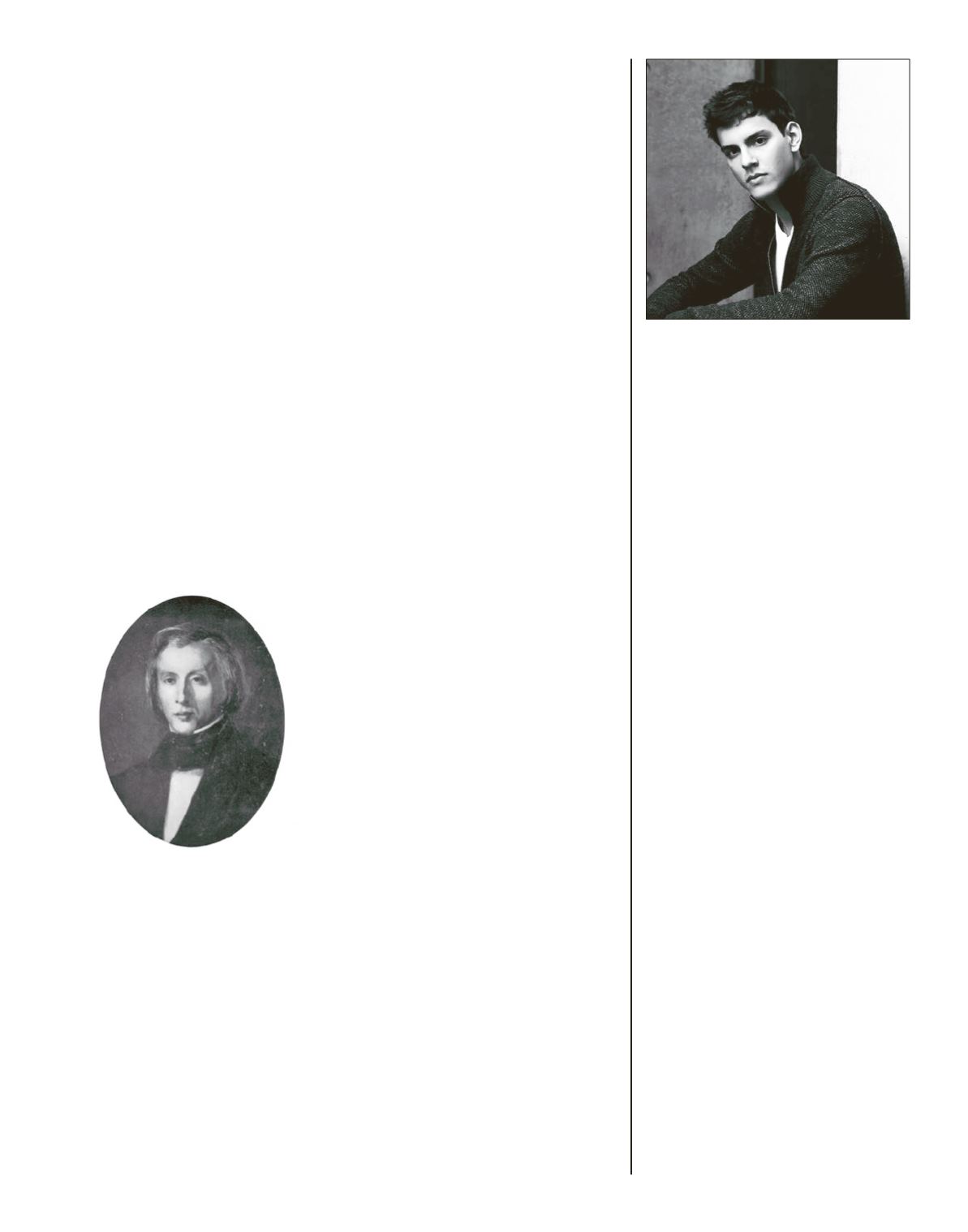
spacer, o en painted or carved, that was used
in ancient Greece to ll spaces between triglyph
blocks. In Szymanowski’s composition, the “tri-
glyphs” are three female characters that Odys-
seus encountered on his journeys: Sirens, the
mythological women/birds whose enchanting
songs lured sailors to their peril; Calypso, the
nymph living on the island of Ogygia who kept
Odysseus captive for seven years; and Nausicaa,
the beautiful young daughter of King Alcinous
and Queen Arete of Phaeacia who cared for the
shipwrecked Odysseus.
FRYDERYK FRANCISZEK CHOPIN (1810–49)
Andante spianato
and
Grande polonaise
brillante
, op.
rongs of th-century piano a cionados, en-
chanted by the exotic strains of Polish dances,
rushed to public recitals by Fryderyk Franciszek
Chopin. During his early tours to Germany and
Austria, Chopin obliged with a steady outpour-
ing of mazurkas and polonaises. While the ma-
zurkas re ected the idyllic side of Polish peas-
antry, the polonaises represented something
more robust and de ant.
e latter-day image
of a diminutive and frail Chopin quickly with-
ers amid the virtuosic grandeur of his dozen
or more polonaises for piano (and occasionally
other instruments).
Franz Liszt, whose own involvement in musical
nationalism culminated in the Hungarian Rhap-
sodies for solo piano, neatly summarized Cho-
pin’s importance to the polonaise tradition. “ e
polonaise is the true and purest type of Polish
national character, as in the course of centuries
it was developed, partly through the political
position of the kingdom toward east and west,
partly through an inde nable, peculiar, inborn
disposition of the entire race. … [Chopin’s] po-
lonaises are the keystone in the development
of the form.
ey belong to the most beautiful
of Chopin’s inspirations. With their energetic
rhythm they electrify, to the point of excited
demonstration, even the sleepiest indi erence.”
While concertizing in Vienna during the win-
ter and spring of
– , Chopin composed his
most ambitious polonaise for piano and orches-
tra, the
Grande polonaise brillante
in E- at ma-
jor, op.
.
is work completed a magni cent
trilogy of solo/orchestral works including his
two piano concertos. Unfortunately, Chopin’s
popularity reached its lowest point during that
tour, and he soon moved permanently to friend-
lier Parisian environs.
e
Andante spianato
is a semi-independent
solo-piano piece in G major, written in
and
subsequently attached as a preface to the
Grande
polonaise brillante
. Gentle, sweeping arpeggios
establish a lyrical setting for the exquisite right-
hand melody. A simple mazurka o ers a morsel
of Polish dance. Smooth (
spianato
) arpeggios
begin again without the theme. A mazurka
phrase concludes this prelude.
e
Grande po-
lonaise brillante
, frequently performed without
orchestral support, introduces a majestic tri-
ple-meter rhythm. Chopin provided an impres-
sive display of Romantic piano virtuosity in this
extended polonaise.
–Program notes ©
Todd E. Sullivan
AARON PILSAN,
piano
Born in Dornbirn, Austria, in
, Aaron Pil-
san began playing piano at age . Now a protégé
of Lars Vogt, he previously worked with Karl
Heinz Kämmerling at the Mozarteum Salz-
burg. His studies have been supported by the
Orpheum Foundation of Switzerland and the
Mozart Gesellscha Dortmund, and in
he
was awarded the Förderpreis Deutschlandfunk
by German Radio and the Musikfest Bremen.
Pilsan he previously been honored as a Rising
Star by the European Concert Hall Organization
and was named Best Young Artist of the Year for
by the German magazine
Fono Forum
. His
performance credits include the stages of Am-
sterdam’s Concertgebouw, Brussels’s Palais des
Beaux Arts, Berlin’s Boulez Saal, Vienna’s Kon-
zerthaus, and the Philharmonie halls of Paris
and Luxembourg. He is also regularly invited to
such festivals as the Menuhin Festival in Gsta-
ad, the Schubertiade, Schwetzingen Festival,
Bregenz Festival, Musikfest Bremen, Klavierfes-
tival Ruhr, Mozartfest
Würzburg, Mecklenburg-
Vorpommern Festival
, and Kissinger Sommer.
An avid chamber musician, Pilsan frequently
performs alongside cellist Kian Soltani, violin-
ist Isabelle Faust, and clarinetist Sharon Kam,
as well as the Szymanowski Quartet and the
Quartetto di Cremona. His repertoire spans not
only Classical- and Romantic-era works, but
also contemporary music from the likes of Jörg
Widmann and
omas Larcher, both of whom
he has worked closely with. Pilsan recently per-
formed the world premiere of a work for cello
and piano by Persian composer Reza Vali at the
Boulez Saal. He made his recording debut on
the French label Naive, presenting a collection
of works by Schubert and Beethoven that was
praised by
Gramophone
Magazine. Earlier this
year Pilsan appeared on Deutsche Grammo-
phon with
Home
, a tribute to Austria featuring
works by Schubert and Schumann recorded
with his longtime duo partner Soltani. Aaron
Pilsan in making his Ravinia debut.
Fryderyk Franciszek Chopin by Antar-Teofil
Kwiatkowski
AUGUST 20 – AUGUST 26, 2018 | RAVINIA MAGAZINE
125








